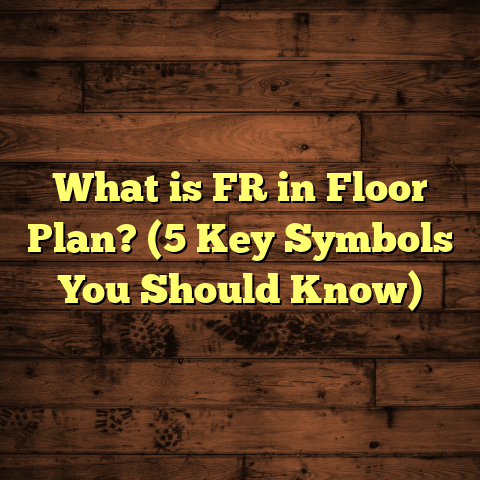What is GFA (Gross Floor Area) in Brisbane? (5 Key Facts)
Low-maintenance flooring options are always on my mind when I’m helping clients redesign their homes. But sometimes, before we even pick the right floor, there’s a bigger picture to understand—especially if you’re dealing with property development or renovations in Brisbane. One term that keeps coming up in these projects is GFA, or Gross Floor Area. Ever wondered what that exactly means and how it impacts your building plans? Let me walk you through it.
What is GFA (Gross Floor Area) in Brisbane?
GFA stands for Gross Floor Area. Simply put, it’s the total floor space within the external walls of a building, including all levels. It measures every square meter (or foot) that you can actually walk on inside the building envelope. This includes living rooms, kitchens, hallways, stairwells, storage rooms—basically all usable floor space.
In Brisbane, GFA is a key measure used by councils and developers to regulate building size and density. It’s essential for planning approvals and zoning compliance. Knowing the GFA helps determine what you can build on your land and how much space you can occupy.
One thing I’ve learned from working with Brisbane properties is that the way GFA is calculated here can sometimes feel a bit tricky. For instance, balconies and garages might be included or excluded depending on the local council’s rules and the specific zoning requirements. That’s why it’s important to check with Brisbane City Council or your local authority before finalizing your floor plans.
How GFA Differs from Other Measurements
You might also hear about Net Floor Area (NFA) or Floor Space Ratio (FSR). These terms are related but different.
- Net Floor Area usually excludes areas like corridors, stairwells, and mechanical rooms—focusing just on usable spaces.
- Floor Space Ratio is a ratio of total floor area to the size of the land parcel. It’s another way councils control density.
In Brisbane, GFA is often the primary measurement for planning approvals, but understanding these differences can help you interpret regulations better.
5 Key Facts About GFA in Brisbane
1. GFA Influences Planning Approvals
When I was helping a client in West End last year, the biggest hurdle was making sure their proposed house fit within the GFA limits set by Brisbane City Council. The council uses GFA to control building bulk and ensure neighborhoods maintain a certain character.
If your design exceeds the allowed GFA, you’ll face delays or even rejection of permits. That happened to a friend of mine who had to redesign his apartment complex because his initial plan overshot the GFA by 15%. So, it pays off to know your limits upfront.
Planning approval involves submitting detailed architectural drawings that include GFA calculations. Councils check these carefully because they want to avoid overly bulky buildings that might overshadow neighbors or negatively affect local infrastructure.
In Brisbane’s inner suburbs like New Farm or Paddington, where heritage feel matters, GFA restrictions are stricter. But in outer suburbs such as Logan or Ipswich, there’s more flexibility allowing larger GFAs proportionate to bigger land plots.
I remember one project where the client wanted a large garage attached to their new home. We had to calculate whether that garage space counted toward the total GFA limit. Turns out, it did count because it was fully enclosed and under the main roofline. That discovery saved us from future compliance problems.
2. Understanding What’s Included and Excluded
You might think calculating GFA is straightforward, but it isn’t always. Brisbane’s regulations include all enclosed spaces but often exclude things like open balconies or uncovered terraces.
For example, in an office building I consulted on, the rooftop garden wasn’t counted towards GFA since it was open-air. However, the enclosed stairwell leading up to it was included. These nuances affect how much space you’re officially allowed to build.
Sometimes covered outdoor areas like verandas or pergolas are excluded if they don’t have solid roofs or walls on all sides. But if they are enclosed with glass or other materials, they might be counted.
Garages can be a grey area too. Some councils exclude detached garages from GFA but include attached ones. It depends on how integrated they are with the main building structure.
I had a case where a client built a partially enclosed patio without knowing it would add to their GFA—resulting in unexpected permit issues. Always clarify with your local council early on.
3. GFA Affects Property Value and Development Potential
I’ve seen firsthand how a larger GFA can increase a property’s value because it allows for more usable floor space. However, a bigger GFA also means higher construction costs and possibly higher rates or taxes.
In one case study from Brisbane’s inner suburbs, properties with a GFA of around 300 square meters sold for approximately 12% more than those with only 200 square meters. But it’s a balancing act; building too large without matching market demand can backfire.
When I helped a family build their dream home in Carindale, they wanted an extra-large open-plan living area and multiple bedrooms—all contributing to a high GFA. While it boosted resale value later on, initial construction costs were higher than anticipated due to the need for quality flooring materials and finishes throughout.
In contrast, I worked on a townhouse project where developers kept the GFA low deliberately to target first-home buyers looking for affordable options. The smaller size helped keep prices competitive but reduced potential rental income slightly.
4. Challenges with Measuring GFA Accurately
Measuring GFA isn’t always simple. I once dealt with a project where discrepancies in architectural drawings caused confusion—some rooms were double-counted because of overlapping mezzanine levels.
This kind of error can lead to costly reworks or fines from the council if discovered during inspections. Precision in measurement and detailed documentation are crucial.
I also found that some older homes don’t have accurate floor plans available—which complicates measuring GFA if you want to renovate or add an extension. In such cases, hiring professional surveyors to measure existing spaces precisely is necessary.
It’s common for builders or homeowners to underestimate how small changes—like enclosing an open porch—can increase the official GFA.
On one project in Brisbane’s northern suburbs, we had to redo plans because original calculations didn’t factor in an underground basement storage area fully enclosed under the main structure.
5. Waste Factor and Material Planning Linked to GFA
When working on flooring installation for buildings with large GFAs, I always account for a waste factor—usually around 5-10% extra material—to cover cutting mistakes or irregular shapes.
For example, a commercial project in Brisbane with a 500 square meter GFA required careful calculation to avoid overspending on flooring materials. Using tools like FloorTally helped me estimate costs accurately based on the exact GFA and other project specifics.
Knowing your precise GFA helps plan not only flooring but also other finishes like painting, tiling, and cabinetry—saving money by reducing over-ordering or underestimating material needs.
In one residential build I worked on in Bulimba with 350 sqm of floor space, we ordered about 8% extra hardwood planks to ensure no shortages during installation due to angled cuts around pillars and irregular room shapes.
My Personal Take on Working Around GFA Regulations
I remember the first time I tackled a multi-level project constrained by strict GFA limits—it was frustrating but also enlightening. The challenge pushed me to get creative with space-saving layouts while keeping the floors functional and stylish.
On another occasion, a client wanted to maximize their home’s footprint but faced tight restrictions due to high-density zoning rules linked directly to GFA caps. We decided to focus on quality materials and clever design tricks like built-in storage and open-plan living to make the smaller floor area feel spacious.
That experience taught me that understanding GFA isn’t just about numbers; it’s about shaping how people live within those limits while respecting regulations.
Another story comes from renovating an old Queenslander house in Paddington where total allowable GFA was capped at 180 sqm. Instead of fighting for more space with council approvals (which could take months), we designed multi-purpose rooms with durable timber flooring that stood up well to heavy use in compact spaces.
Detailed Data on Brisbane’s GFA Regulations
According to Brisbane City Council planning documents updated in 2023:
- Residential zones typically have maximum allowable GFAs ranging from 150 sqm in high-density inner-city areas up to 400 sqm in suburban zones.
- Mixed-use developments often allow larger GFAs but impose conditions like green space requirements or parking minimums.
- Commercial zones vary widely depending on use—from small retail shops (around 200 sqm limits) up to large offices with thousands of square meters permitted under specific precinct plans.
- The council applies different measurement rules depending on zone codes such as Low Density Residential (LDR), Medium Density Residential (MDR), and High Density Residential (HDR).
These numbers can change depending on your property’s specific location within Brisbane boundaries—so always check current zoning maps and guidelines.
Case Study: Residential Development in Brisbane’s Inner West
Let me share a real example from a project I was involved with last year in Toowong:
The client wanted to build a duplex on a relatively small block (about 450 sqm land size). The allowable Floor Space Ratio was 0.6:1, which meant they could have up to 270 sqm of total floor area combined between both units.
Our challenge was:
- Designing two comfortable homes while staying within this 270 sqm limit.
- Balancing indoor living spaces against outdoor courtyards which don’t count toward GFA.
- Making sure all rooms had natural light without increasing window wall areas excessively (which can be counted differently).
We ended up creating efficient floor plans with clever zoning—living areas downstairs, bedrooms upstairs—and using timber-look vinyl flooring throughout for durability and easy maintenance.
This balance helped get council approval quickly and resulted in two attractive homes sold above market average due to smart use of available space under strict GFA control.
How I Use Tools Like FloorTally for Accurate Estimation
FloorTally has been a game changer for me when estimating flooring costs based on Gross Floor Area details from architectural plans.
By inputting precise room dimensions and accounting for waste factors automatically, I get:
- Accurate material estimates
- Cost breakdowns by labor and materials
- Time-saving consolidation of multiple quotes into one platform
For example, when working on a recent commercial fit-out near Brisbane CBD with complex floor layouts totaling over 800 sqm of floor space across several levels—I relied heavily on these tools for budgeting materials like timber flooring versus vinyl alternatives based on wear resistance needs.
It also helps clients visualize cost implications of increasing or decreasing floor areas during design tweaks without redoing manual calculations each time.
The Relationship Between GFA and Sustainable Building Practices
I’m asked often about whether focusing on maximizing GFA conflicts with sustainable building goals. From what I’ve seen:
- Bigger isn’t always better for sustainability.
- Efficient use of space within allowed GFAs reduces resource use per occupant.
- Choosing low-impact flooring materials within your GFA budget supports greener outcomes.
In Brisbane, new developments increasingly emphasize eco-friendly designs that balance usable floor area with energy efficiency and environmental considerations like solar access and rainwater harvesting.
One project I worked on incorporated bamboo flooring—a renewable resource—within a modest 220 sqm house designed under tight GFA controls. The result was a stylish yet environmentally conscious home that met both client expectations and council rules.
Tips for Homeowners Dealing with GFA Issues
Here are some practical tips based on my experiences:
- Get familiar with your local zoning laws early — don’t wait until design is finished.
- Work closely with architects who understand Brisbane’s unique rules about what counts as floor area.
- Consider alternative layouts like split-levels or mezzanines if allowed—they can increase usable space without increasing footprint.
- Use trusted tools like FloorTally for precise cost estimates tied directly to your calculated GFA.
- Plan for waste when ordering materials—underestimating leads to delays and extra costs.
- Be transparent with contractors about your maximum allowable floor area so everyone stays aligned.
- Explore flexible living spaces that serve multiple purposes within limited floor areas.
- Consult council officers early if unsure about inclusion/exclusion of certain spaces like carports or balconies.
Common Questions I Get About GFA
Does covered outdoor space count towards GFA?
Generally no if it’s open-sided without walls or doors—but check local definitions carefully.
How do basements affect Gross Floor Area?
Fully enclosed basements usually count towards total GFA unless specifically excluded by council policies.
Can I increase my allowable GFA by paying fees or contributions?
Some councils offer bonus floor area provisions linked to infrastructure contributions—Brisbane occasionally allows this under specific development schemes but it’s not guaranteed.
How precise does my measurement have to be?
Very precise measurements backed by professional drawings are required during approvals. Approximate numbers won’t cut it once construction starts.
What happens if my built floor area exceeds approved GFA?
You could face fines, orders for modification/demolition of non-compliant parts, or difficulties selling your property later due to non-conformance issues.
Wrapping Up My Thoughts
Understanding Gross Floor Area in Brisbane is one of those behind-the-scenes details that can make or break your project—from tiny renovations to large-scale developments. It affects everything from planning approval to material budgeting and even resale value down the line.
If you’re planning construction or renovation here:
- Get familiar with local council rules early.
- Keep communication clear with architects, builders, and flooring specialists like me.
- Use precise measurements and professional tools.
- Plan your budgets around realistic estimates tied directly to your exact allowable floor area.
Have you encountered issues with floor area rules before? Or maybe you’re just starting out? Feel free to ask—I’m here to help!





